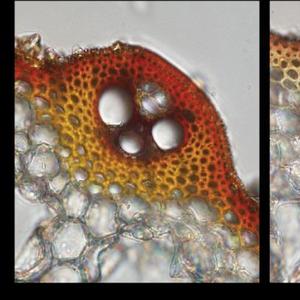HKU, Kyoto U enhance efficiency of cereal straw for biofuel




The University of Hong Kong
May 11, 2017
BY The University of Hong Kong
Straw is commonly used for feeding animals, burning, baling, etc. As one of the “Three Canton Treasures,” straw can actually be used as a raw material to produce biofuel.
Ethanol, an alcohol, is a clean and renewable biofuel traditionally produced by fermentation of sucrose from sugarcane or glucose released from corn starch. With an increasing demand on biofuel in recent years, cellulose from non-edible plant materials (e.g. sugarcane leaves, corn stalks, rice straw) has been used as raw materials for bioethanol production. However, since cellulose is crosslinked with lignin in plant cell walls, it is very difficult to release glucose from cellulose.
A collaborative research effort by the University of Hong Kong and Kyoto University has revealed a new strategy to allow cellulose in rice straw to release its fermentable sugar more efficiently. The research breakthrough was recently published in a notable plant science journal Plant Physiology.
Advertisement
Advertisement
Lignin is a complex polymer which functions to provide mechanical strength and structural integrity in plants. However, expensive and complicated procedures are required to loosen the lignin barrier in order to utilize cellulose more efficiently during the production of bioethanol.
Rice and other cereals belong to the grass family (Poaceae). Lignin in their stems and leaves contain a special component called tricin. HKU plant biochemists Clive Lo Sze-chung and his student Lydia Lam Pui-ying, together with Kyoto U lignin specialist Yuki Tobimatsu, started a collaborative project two years ago. According to their discovery, when flavone synthase II (FNSII), a key enzyme involved in tricin synthesis, is knocked out, not only is tricin not produced, but the lignin content in rice straw was also reduced by approximately one-third. In addition, the yield of glucose from cellulose degradation was increased by 37 percent without any chemical treatment.
Glucose released from cellulose can be used for bioethanol production. In other words, it is more efficient to produce ethanol from this kind of rice straw: the cost of lignin treatment can be reduced and the production of ethanol can be enhanced.
Advertisement
Advertisement
“This is the first demonstration of the reduction of cell wall lignin content in rice straw by the disruption of tricin production,” said Clive Lo, “Importantly, there are no negative impacts on rice growth and productivity.” As plants in the grass family all contain tricin-bound lignin, this strategy can be applied to other cereals like maize, wheat, and barley as well as grass species (e.g. sorghum and switchgrass) cultivated around the world exclusively for ethanol production, so that they can be utilized more efficiently as raw materials for biofuel.
Lydia Lam has been recently awarded the JSPS Postdoctoral Fellowship for Research in Japan by the Japan Society for the Promotion of Science and will start her postdoctoral research at Kyoto U this September. She said, "I feel very delighted and honored to conduct a research project that could benefit society. Also, as a Hongkonger, I am always trained to work quickly and efficiently. During the eight-month research experience at Kyoto U, I was particularly impressed by the students there. They performed experiments with extreme care and precision. When I am doing research today, I always ask myself to do better than perfect in addition to seeking speed and efficiency."
Related Stories
The U.S. Department of Energy Bioenergy Technologies Office (BETO) announced up to $23 million in funding to support research and development (R&D) of domestic chemicals and fuels from biomass and waste resources.
The U.S. DOE has announced its intent to issue funding to support high-impact research and development (R&D) projects in two priority areas: sustainable propane and renewable chemicals and algal system cultivation and preprocessing.
Sens. Sherrod Brown, D-Ohio, and Pete Ricketts, R-Neb., in August introduced the Renewable Chemicals Act, a bill that aims to create a tax credit to support the production of biobased chemicals.
The Chemical Catalysis for Bioenergy Consortium, a consortium of the U.S. DOE’s Bioenergy Technologies Office, has launched an effort that aims to gather community input on the development of new biomass processing facilities.
USDA on March 8 celebrated the second annual National Biobased Products Day, a celebration to raise public awareness of biobased products, their benefits and their contributions to the U.S. economy and rural communities.
Upcoming Events










